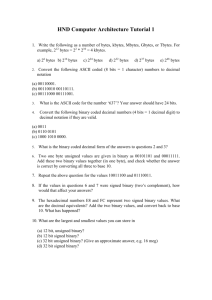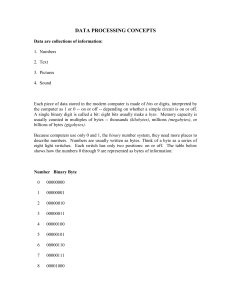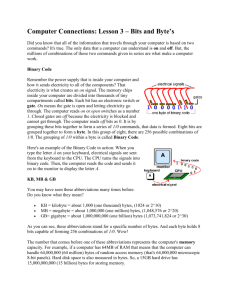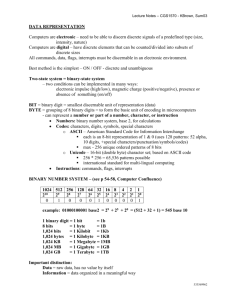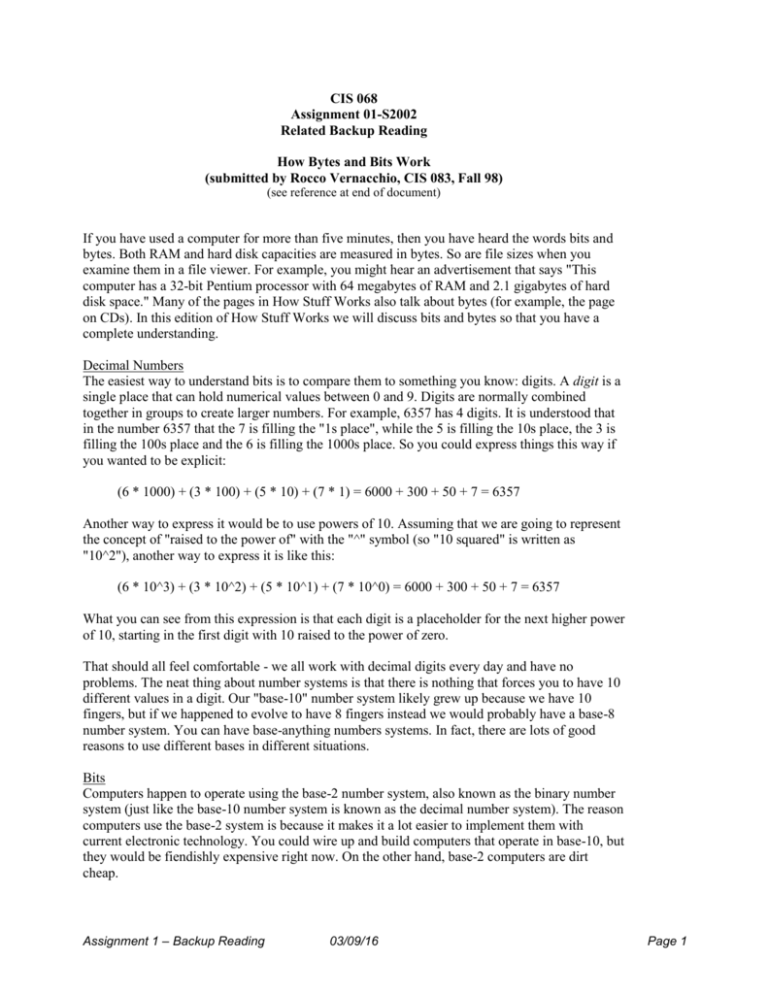
CIS 068
Assignment 01-S2002
Related Backup Reading
How Bytes and Bits Work
(submitted by Rocco Vernacchio, CIS 083, Fall 98)
(see reference at end of document)
If you have used a computer for more than five minutes, then you have heard the words bits and
bytes. Both RAM and hard disk capacities are measured in bytes. So are file sizes when you
examine them in a file viewer. For example, you might hear an advertisement that says "This
computer has a 32-bit Pentium processor with 64 megabytes of RAM and 2.1 gigabytes of hard
disk space." Many of the pages in How Stuff Works also talk about bytes (for example, the page
on CDs). In this edition of How Stuff Works we will discuss bits and bytes so that you have a
complete understanding.
Decimal Numbers
The easiest way to understand bits is to compare them to something you know: digits. A digit is a
single place that can hold numerical values between 0 and 9. Digits are normally combined
together in groups to create larger numbers. For example, 6357 has 4 digits. It is understood that
in the number 6357 that the 7 is filling the "1s place", while the 5 is filling the 10s place, the 3 is
filling the 100s place and the 6 is filling the 1000s place. So you could express things this way if
you wanted to be explicit:
(6 * 1000) + (3 * 100) + (5 * 10) + (7 * 1) = 6000 + 300 + 50 + 7 = 6357
Another way to express it would be to use powers of 10. Assuming that we are going to represent
the concept of "raised to the power of" with the "^" symbol (so "10 squared" is written as
"10^2"), another way to express it is like this:
(6 * 10^3) + (3 * 10^2) + (5 * 10^1) + (7 * 10^0) = 6000 + 300 + 50 + 7 = 6357
What you can see from this expression is that each digit is a placeholder for the next higher power
of 10, starting in the first digit with 10 raised to the power of zero.
That should all feel comfortable - we all work with decimal digits every day and have no
problems. The neat thing about number systems is that there is nothing that forces you to have 10
different values in a digit. Our "base-10" number system likely grew up because we have 10
fingers, but if we happened to evolve to have 8 fingers instead we would probably have a base-8
number system. You can have base-anything numbers systems. In fact, there are lots of good
reasons to use different bases in different situations.
Bits
Computers happen to operate using the base-2 number system, also known as the binary number
system (just like the base-10 number system is known as the decimal number system). The reason
computers use the base-2 system is because it makes it a lot easier to implement them with
current electronic technology. You could wire up and build computers that operate in base-10, but
they would be fiendishly expensive right now. On the other hand, base-2 computers are dirt
cheap.
Assignment 1 – Backup Reading
03/09/16
Page 1
So computers use binary numbers, and therefore use binary digits in place of decimal digits. The
word bit is a shortening of the words "Binary digIT". Where decimal digits have 10 possible
values ranging from 0 to 9, bits have only 2 possible values: 0 and 1. Therefore a binary number
is composed of only 0s and 1s, like this: 1011. How do you figure out what the value of the
binary number 1011 is? You do it in the same way we did it above for 6357, but you use a base of
2 instead of a base of 10. So:
(1 * 2^3) + (0 * 2^2) + (1 * 2^1) + (1 * 2^0) = 8 + 0 + 2 + 1 = 11
You can see that in binary numbers, each bit holds the value of increasing powers of 2. That
makes counting in binary pretty easy. Starting at zero and going though 20, counting in decimal
and binary looks like this
0
1
2
3
4
5
6
7
8
9
10
11
12
13
14
15
16
17
18
19
20
=
=
=
=
=
=
=
=
=
=
=
=
=
=
=
=
=
=
=
=
=
0
1
10
11
100
101
110
111
1000
1001
1010
1011
1100
1101
1110
1111
10000
10001
10010
10011
10100
When you look at this sequence, 0 and 1 are the same for decimal and binary number systems. At
the number 2 you see carrying first take place in the binary system. If a bit is 1, and you add 1 to
it, the bit becomes zero and the next bit becomes 1. In the transition from 15 to 16 this effect roles
over through 4 bits, turning 1111 into 10000.
Bytes
Bits are rarely seen alone in computers. They are almost always bundled together into 8-bit
collections, and these collections are called bytes. Why are there 8 bits in a byte? A similar
question is, "Why are there 12 eggs in a dozen?" The 8-bit byte is something that people settled
on through trial and error over the past 50 years.
Assignment 1 – Backup Reading
03/09/16
Page 2
With 8 bits in a byte, you can represent 256 values ranging from 0 to 255, as shown here:
0 = 00000000
1 = 00000001
2 = 00000010
...
254 = 11111110
255 = 11111111
A typical CD uses 2 bytes, or 16 bits, per sample. A two-byte or 16 bit representation gives each
sample a range from 0 to 65,535, like this:
0 = 0000000000000000
1 = 0000000000000001
2 = 0000000000000010
...
65534 = 1111111111111110
65535 = 1111111111111111
Bytes are frequently used to hold individual characters in a text document. In the ASCII character
set, each binary value between 0 and 127 is given a specific character. Most computers extend the
ASCII character set to use the full range of 256 characters available in a byte. The upper 128
characters handle special things like accented characters from common foreign languages.
The table at the right shows the 127 standard ASCII codes. Computers store text documents, both
on disk and in memory, using these codes. For example, if you use Notepad in Windows 95 to
create a text file containing the words, "Four score and seven years ago", Notepad would use one
byte of memory per character. When Notepad stores the sentence in a file on disk, the file will
contain one byte per character. Try this experiment: open up a new file in Notepad and insert the
sentence, "Four score and seven years ago" in it. Save the file to disk under the name getty.txt.
Then use the explorer and look at the size of the file. You will find that the file has a size of 30
bytes on disk: one byte for each character. If you add another word to the end of the sentence and
re-save it, the file size will jump to the appropriate number of bytes. Each character consumes a
byte.
If you were to look at the file as a computer looks at it, you would find that each byte contains not
a letter but a number. The number is the ASCII code corresponding to the character. So on disk
The numbers for the file look like this:
F
o
u
r
a
n
d
s
e
v
e
n
070 111 117 114 032 097 110 100 032 115 101 118 101 110 032
By looking in an ASCII code table (which you can you can see a one-to-one correspondence
between each character and the ASCII code used. Note the use of 32 for a space - 32 is the right
ASCII code for a space. We could expand these decimal numbers out to binary numbers (so 32 =
00100000) if we wanted to be technically correct - that is how the computer really deals with
things.
Assignment 1 – Backup Reading
03/09/16
Page 3
Lots of Bytes
When you start talking about lots of bytes, you get into prefixes like Kilo, Mega and Giga, as in
Kilobyte, Megabyte and Gigabyte (also shortened to K, M and G, as in Kbytes, Mbytes and
Gbytes or KB, MB and GB). The following table shows the multipliers:
Name
Kilo
Mega
Giga
Tera
Peta
Abbrev
K
M
G
T
P
Size
2^10 = 1,024
2^20 = 1,048,576
2^30 = 1,073,741,824
2^40 = 1,099,511,627,776
2^50 = 1,125,899,906,842,624
You can see in this chart that Kilo is about a thousand, mega is about a million, giga is about a
billion, and so on. So when someone says "this computer has a 2 Gig hard drive", what he/she
means is "2 gigabytes", which means approximately 2 billion bytes, and means actually
2,147,483,648 bytes. How could you possible need 2 gig of space? When you consider that one
CD holds 650 meg, you can see that just 3 CDs worth of data will fill the whole thing! Terabyte
database are fairly common these days, and there are probably a few petabyte databases floating
around the Pentagon by now.
Binary Math
Binary math works just like decimal math, except that the value of each bit can be only 0 or 1. To
get a feel for binary math, let's start with decimal addition and see how it works. Assume we want
to add 452 and 751:
452
+ 751
--1203
To add these 2 numbers together you start at the right. 2 + 1 = 3. No problem. 5 + 5 = 10, so you
save the zero and carry the 1 over to the next place. 4 + 7 + 1 (because of the carry) = 12. You
save the 2 and carry the 1. 0 + 0 + 1 = 1. So the answer is 1203.
Binary addition works exactly the same way:
010
+ 111
--1001
Starting at the right, 0 + 1 = 1 for the first digit. No carrying there. 1 + 1 = 10 for the second digit,
so save the 0 and carry the 1. 0 + 1 + 1 = 10 for the third digit. So save the zero and carry the 1. 0
+ 0 + 1 = 1. So the answer is 1001. If you translate everything over to decimal you can see it is
correct: 2 + 7 = 9.
To see how boolean addition is implemented using gates, see the How Stuff Works article on
Boolean logic.
Assignment 1 – Backup Reading
03/09/16
Page 4
Recapping
So to recap:
* We have bits, or binary digits. A bit can hold the value 0 or 1.
* We have bytes, made up of 8 bits.
* Binary math works just like decimal math, but each bit can have a value of only 0 or 1.
There really is nothing more to it - bits and bytes are that simple!
Reference:
How Stuff Works (http://www.howstuffworks.com) is a production of [BYG Publishing] BYG
Publishing, Inc. http://www.bygpub.com - questions@bygpub.com (919) 269-5880 - P.O.
Box 40492 - Raleigh, NC 27629.
(c) 1998 BYG Publishing, Inc. All rights reserved.
Assignment 1 – Backup Reading
03/09/16
Page 5



